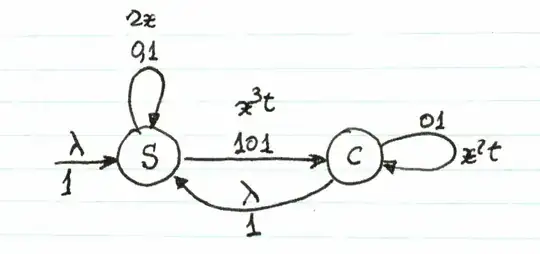Here is an observation. While I am certain that the above advanced treatment deserves prominence, I would like to point out that one can get good results (bivariate generating functions) simply by analysing a minimal automaton with the prefixes of $w$ as states and computing the transitions from one prefix to another so that the maximum prefix is chosen at every step, and thereafter solving the resulting system of probability generating functions. Very simple indeed. The generating functions are in $z$ and $u$ where $z$ indexes the length of the string and $u$ the number of occurrences of $w.$ These yield conditional results, i.e. the PGF for a certain state gives the probability distribution of ocurrences of $w$ as a polynomial in $u$ (which is the coefficient of $z^n$ of the PGF) given that the automaton is in that state. To get all occurrences, sum the PGFs for all states and extract coefficients.
The example has $w=101$, giving generating functions
$$\begin{align}
a & =-2\,{\frac {{z}^{2}u+2\,z-4}{8-8\,z-2\,{z}^{2}u+{z}^{3}u+2\,{z}^{2}-{z}^
{3}}},\\
a_1 & =-{\frac { \left( -4+{z}^{2}u \right) z}{8-8\,z-2\,{z}^{2}u+{z}^{3}u+
2\,{z}^{2}-{z}^{3}}}\\
a_{10} & =2\,{\frac {{z}^{2}}{8-8\,z-2\,{z}^{2}u+{z}^{3}u+2\,{
z}^{2}-{z}^{3}}}\\
a_{101} & ={\frac {{z}^{3}u}{8-8\,z-2\,{z}^{2}u+{z}^{3}u+2\,{z}^{2}-{z}^{3}}}
\end{align}$$
Add these and simplify to obtain
$$ g(z, u) = -2\,{\frac {{z}^{2}u-4-{z}^{2}}{8-8\,z-2\,{z}^{2}u+{z}^{3}u+2\,{z}^{2}-{z}^{3}}}.$$
Finally extract the coefficient of $[u^2]$, getting
$$ [u^2] g(z, u) = 8\,{\frac {{z}^{5} \left( -2+z \right) }{ \left( -8+8\,z-2\,{z}^{2}+{z}^{3}\right) ^{3}}}.$$
Now the coefficients (times $2^n$ because we have a PGF) of this last term are (starting from $n=5$)
$$1, 5, 15, 38, 91, 210, 468, 1014, 2151, 4487, 9229, 18756, 37728, 75219, 148803, 292354,$$
and there are indeed fifteen of these for $n=7$.
Let's treat another example, taking $w=1111.$ We get the following set of PGFs:
$$\begin{align}
a & =-8\,{\frac {-2+uz}{16-8\,uz-8\,z+4\,{z}^{2}u-4\,{z}^{2}+2\,{z}^{3}u-2\,{
z}^{3}+{z}^{4}u-{z}^{4}}}\\
a_{1} & =-4\,{\frac {z \left( -2+uz \right) }{16-8\,uz-8
\,z+4\,{z}^{2}u-4\,{z}^{2}+2\,{z}^{3}u-2\,{z}^{3}+{z}^{4}u-{z}^{4}}}\\
a_{11} & =-2\,
{\frac {{z}^{2} \left( -2+uz \right) }{16-8\,uz-8\,z+4\,{z}^{2}u-4\,{z}^{2}+2\,{z}^
{3}u-2\,{z}^{3}+{z}^{4}u-{z}^{4}}}\\
a_{111} & =-{\frac {{z}^{3} \left( -2+uz
\right) }{16-8\,uz-8\,z+4\,{z}^{2}u-4\,{z}^{2}+2\,{z}^{3}u-2\,{z}^{3}+{z}^{4}u-{z}
^{4}}}\\
a_{1111} & ={\frac {{z}^{4}u}{16-8\,uz-8\,z+4\,{z}^{2}u-4\,{z}^{2}+2\,{z}^{3
}u-2\,{z}^{3}+{z}^{4}u-{z}^{4}}}
\end{align}$$
Add and simplify to get
$$ g(z,u) = -2\,{\frac {-8+4\,uz-4\,z+2\,{z}^{2}u-2\,{z}^{2}+{z}^{3}u-{z}^{3}}{16-8\,uz-8\,z+4\,{z}^{2}u-4\,{z}^{2}+2\,{z}^{3}u-2\,{z}^{3}+{z}^{4}u-{z}^{4}}}.
$$
Now suppose we wanted the count with four ocurrences of $w$ which has PGF
$$ [u^4] g(z,u) = 16\,{\frac {{z}^{7} \left( -8+4\,z+2\,{z}^{2}+{z}^{3} \right) ^{3}}{ \left( -16+8\,
z+4\,{z}^{2}+2\,{z}^{3}+{z}^{4} \right) ^{5}}}.$$
Clearly we need at least seven bits, and indeed the sequence (times $2^n$ because we have a PGF) of the coefficients of this last term is (starting from $n=7$)
$$ 1, 2, 5, 12, 31, 71, 163, 369, 829, 1835, 4032, 8795, 19064, 41081.$$
I am posting the Maple code that I used to compute these and the reader is invited to try it out by invoking the function "eqsys" with a list of bits (the word $w$).
Here is a challenge for the reader: verify independently that the cumulative PGF for $w=10101$ is given by
$$ g(z, u) = -2\,{\frac {4\,{z}^{2}u-16-4\,{z}^{2}+{z}^{4}u-{z}^{4}}{8\,{z}^{3}u-32\,z-8\,{z}^{2
}u+32-8\,{z}^{3}-2\,{z}^{4}u+8\,{z}^{2}+2\,{z}^{4}-{z}^{5}+{z}^{5}u}}.$$
This is the Maple code:
prfx :=
proc(w, ww)
local pos, s1, s2;
for pos from nops(ww) to 1 by -1 do
s1 := cat(seq(w[k], k=1..pos));
s2 := cat(seq(ww[k], k=nops(ww)-pos+1..nops(ww)));
if s1=s2 then return s1; fi;
od;
return "";
end;
eqsys :=
proc(w)
local mx, prf, ww, ww_name, sysl, eq, eqs_tbl;
sysl := [];
for mx from 0 to nops(w)-1 do
ww := [seq(w[k], k=1..mx), 0];
ww_name := cat(`a`, seq(ww[k], k=1..nops(ww)-1));
prf := cat(`a`, prfx(w, ww));
sysl := [op(sysl), [prf, ww_name, 0]];
ww := [seq(w[k], k=1..mx), 1];
ww_name := cat(`a`, seq(ww[k], k=1..nops(ww)-1));
prf := cat(`a`, prfx(w, ww));
sysl := [op(sysl), [prf, ww_name, 1]];
od;
ww := [seq(w[k], k=2..nops(w)), 0];
ww_name := cat(`a`, seq(w[k], k=1..nops(w)));
prf := cat(`a`, prfx(w, ww));
sysl := [op(sysl), [prf, ww_name, 0]];
ww := [seq(w[k], k=2..nops(w)), 1];
ww_name := cat(`a`, seq(w[k], k=1..nops(w)));
prf := cat(`a`, prfx(w, ww));
sysl := [op(sysl), [prf, ww_name, 1]];
print(sysl);
eqs_tbl := table();
for v in indets(sysl) do
if v = `a` then
eqs_tbl[v] := 1;
else
eqs_tbl[v] := 0;
fi;
od;
ww_name = cat(`a`, seq(w[k], k=1..nops(w)));
for eq in sysl do
if eq[1] = ww_name then
eqs_tbl[eq[1]] :=
eqs_tbl[eq[1]] + 1/2*u*z*eq[2];
else
eqs_tbl[eq[1]] :=
eqs_tbl[eq[1]] + 1/2*z*eq[2];
fi;
od;
sysl := [];
for eq in [indices(eqs_tbl, 'nolist')] do
sysl := [op(sysl), eq = eqs_tbl[eq]];
od;
print(sysl);
solve(sysl, indets(sysl) minus {u,z});
end;
